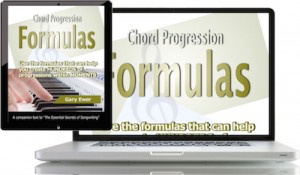The typical 3-chord song has been the workhorse of early rock and roll. Go back to the 50s, and it’s the mainstay of most songs. By 3-chord songs, we’re talking usually about this progression:
I IV V7 I (C F G7 C)
And then, of course, the writer might throw something else in, particularly in the verse. So you might also see ii-chords (Dm in the key of C major), or vi-chords (Am). The iii-chord (Em) back in those days was much less common, and the vii° usually least commonly used.
 Just need chords to get your songwriting process started? “The Essential Secrets of Songwriting 10-eBook Bundle contains several eBooks that deal exclusively with chords, including chord collections, harmonizing melodies, and “Chord Progression Formulas”
Just need chords to get your songwriting process started? “The Essential Secrets of Songwriting 10-eBook Bundle contains several eBooks that deal exclusively with chords, including chord collections, harmonizing melodies, and “Chord Progression Formulas”
Songwriters today are often looking for something that might add a bit more “spice” to their songs, so it’s not uncommon to see longer progressions that take the listener on a bit of a more extensive journey.
But it can be tricky to get those longer progressions to work properly without having the audience feel a bit lost. There’s another alternative, which is to create progressions that replace the two inner chords of the I-IV-V-I progression with something more interesting.
If you’ve wanted changes that are a little less than typical, but don’t want to create long 15-chord progressions, here are some to experiment with (with examples from C major). They’ll work in any section of your song, particularly the verse, chorus — maybe not so easily used in pre-choruses or bridge sections:
1. I bIII IV I (C Eb F C)
The flat-III is a great non-diatonic chord that adds an edge to your music, and you’ll find it in many songs that feature a faster tempo and grittier sound. (Example: “Superstar” (Andrew Lloyd Webber, Tim Rice)
2. I ii bVII I (C Dm Bb C)
What I like about this progression is that it gives the appearance at the start of a rising bass line, but then changes its mind and jumps down to the flat-VII. If you want a longer progression, that flat-VII can also move to vi, IV, or back to ii.
3. I bVI bIII I (C Ab Eb C)
As a nice alternative to this progression, try it with a tonic pedal: keeping the tonic note C in the bass through the changes.
4. I I°7 V6 I (C Cdim7 G/B C)
The G/B is an inversion (a “slash chord”) which means to play a G chord with the note B as the lowest-sounding one. This progression makes a nice start for a verse, from which you can then create other progressions that take that section on a longer musical journey.
5. I iii bIIImaj7 I (C Em Ebmaj7 C)
Non-diatonic chords like the Eb chord will move easily to IV chords, but you’ll notice that when you leap back to the tonic chord from bIII there’s almost a momentary feeling of the “twisting” of tonality. That twisting comes primarily from the flat-III note itself (Eb), but also the Bb in that chord, both of which disappear when the I chord happens.
These are just a few possibilities. I’d encourage you to experiment as much as possible. Because these are short progressions (three chords, with the first one then repeated at the end), you don’t have to give a lot of thought to how to “get back” to the tonic. Jumping back, as you can hear, usually works just fine.
 Written by Gary Ewer. Follow on Twitter.
Written by Gary Ewer. Follow on Twitter.
 “The Essential Secrets of Songwriting” eBook Bundle looks at songwriting from every angle, and has been used by thousands of songwriters. How to use chords, write melodies, and craft winning lyrics. GET TODAY’S SPECIAL GIFT.
“The Essential Secrets of Songwriting” eBook Bundle looks at songwriting from every angle, and has been used by thousands of songwriters. How to use chords, write melodies, and craft winning lyrics. GET TODAY’S SPECIAL GIFT.










